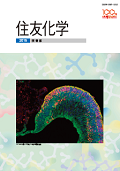FY 2015
2015.7.31 issue
-
Vector control is the most important method to disrupt transmission of insect-borne diseases, such as malaria or dengue fever. Long-lasting insecticidal nets (LLINs) and indoor residual sprays (IRS) are major tools for malaria vector control. Recently we have developed two new LLINs and one IRS formulation. Olyset®Plus is a durable LLIN containing 2% (w/w) permethrin combined with 1% (w/w) piperonyl butoxide (PBO) with enhanced efficacy against pyrethroid resistant mosquitoes. Olyset®Duo is also a durable LLIN containing 2% (w/w) permethrin and 1% (w/w) pyriproxyfen. Olyset®Duo has sterilizing and life-shortening effects against pyrethroid resistant mosquitoes. SumiShield®50WG is a new IRS formulation containing clothianidin which is a new mode of action insecticide for vector control. SumiShield®50WG shows excellent residual efficacy against both resistant and susceptible anopheline mosquitoes on various wall materials. As for dengue vector control, larviciding and space spraying are dominant tools. SumiLarv®2MR is a new long-lasting “matrix release” larvicide based on pyriproxyfen that has been specially designed for container breeding mosquitoes. SumiPro®EW is a new space spray formulation with low water evaporation properties that allows spray droplets to travel up to 100 m from the point of application.Minimal shrinkage of water droplets maintains a superior knock-down and kill activity of SumiPro®EW against dengue vector mosquitoes. This paper described the key features of the products that provide improved control for insecticide-resistant malaria and dengue vectors.
(by Kazunori OHASHI, Yoshinori SHONO)
-
GaAs based compound semiconductors have been widely used for mobile applications in devices, such as smartphones, tablet PCs, base stations, and so on, because of their superior RF properties.
One of their major applications is the FEMs (Front-End Modules) of mobile phones, and InGaP-HBT which is suitable for power amplifiers in FEMs has been developed. In this paper InGaP-HBT epitaxial wafer fabrication techniques using MOCVD growth method are reviewed.
(by Tomoyuki TAKADA, Noboru FUKUHARA, Hisashi YAMADA, Masahiko HATA, Yasuyuki KURITA)
-
Recent progress in simulation and computer technology has helped the growth of computational materials science. Computer aided design of materials with high functionality based on theories of materials science has become an important and essential part of research and development in our company. Here, we introduce our work on the computational analysis of inorganic fluorescent and organic semiconductor materials. Also, we show how recent progress in this field can influence the directions of our research in the future.
(by Masaya ISHIDA, Yasuyuki KURITA, Akiko NAKAZONO)
-
Practical methodology has been developed for the application of Predictive Functional Control (PFC) to certain processes which conventional Proportional-Integral-Derivative (PID) controllers have difficulty in handling. PFC is a variant of the widely-used Model Predictive Control (MPC) technology, and is characterized by its excellent control performance with a fairly simple calculation algorithm. PFC can be implemented using the standard functionalities of DCS (Distributed Control Systems) and PLC (Programmable Logic Controllers), which makes it easier than conventional MPC packages to implement and maintain in existing control systems. In this paper, a general explanation of PFC as well as illustrative examples of its practical application will be described.
(by Satoru HASHIZUME)
